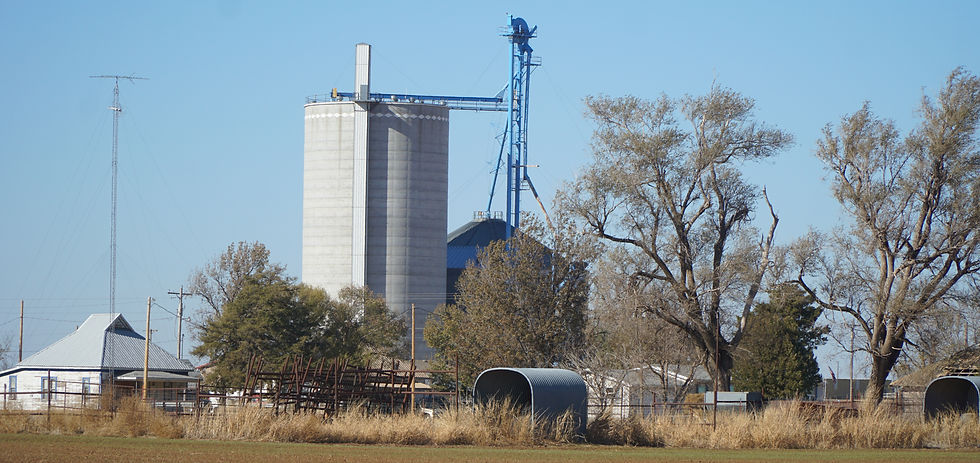
Town of Amorita, Oklahoma
Visit Amorita
Amorita is one of Alfalfa County's favorite little historic towns, established in 1901 in Oklahoma Territory as the Byron Township of Woods County. Rumor has it that it is named after the wife of railroad owner, Charles E. Ingersoll, who lent his sir name to another Alfalfa County town just down the road. A trip through Amorita won't take you long, it's true, but there's plenty to do along the way. Take in some of Alfalfa County's top attractions and scenery during a road trip to the little town of Amorita, Oklahoma.
Plan a Road Trip to Amorita
Where to Shop
Restaurants - Food & Drink
Places to Stay
Amorita Public Services
Getting Around Amorita, Okla.
Amorita is about a 25-minute drive north of Salt Plains State Park. From the park entrance, head north on OK-38 through the town of Nesatunga. Continue north on OK-38 to the intersection of OK-11.
Backroad Route
From OK-11 intersection, go north 3 miles, and turn west on Latimer Road. Travel 7 miles to OK-58 in Byron. You'll see the Amorita & Byron Fire Department on the corner. Turn north on OK-58 and drive 1 3/4 miles to Amorita.
Highway Route
From OK-11 intersection, go west 11 miles, turn north on OK-58. Drive 7 miles north through the ghost town of Driftwood. Turn east, and go 4 miles to OK-58. Drive 1 3/4 miles north to Amorita.
History of Amorita, Oklahoma
Coming Soon!
-
What's in Cherokee, Oklahoma?The county seat of Alfalfa County, Oklahoma, Cherokee features several year-round attractions and things to do for travelers to Northwest Oklahoma. Cherokee has three public parks, including an educational nature park with walking trails, a scenic park with tennis courts and a community park with a swimming pool. The town hosts the annual Great Salt Plains Stampede Rodeo in September and several activities during the Salt Plains Crystal and Birding Festival in April. While the town was established during the Cherokee Strip Land Run, it is not part of Cherokee Nation and does not sit on any part of the Cherokee Reservation. Learn more about what's in Cherokee, Oklahoma, including the history of the town, where to shop, restaurants, places to stay and things to do, at Alfalfa County Buzz.
-
What county is Cherokee, OK, in?Cherokee, Oklahoma, is the county seat of Alfalfa County. Cherokee is part of the Great Salt Plains area in Northwest Oklahoma, known as Red Carpet Country. The town is often mistaken for Cherokee Nation, the federally recognized Native American tribe, located in eastern Oklahoma. While the city of Cherokee was established as a result of the The Land Run of 1893, also known as the Cherokee Outlet Opening or the Cherokee Strip Land Run, the town does not sit on any part of Cherokee Nation reservation.
-
When was the Cherokee Strip Land Run in Oklahoma?The Cherokee Strip Land Run in Oklahoma took place on September 16, 1893. It was the largest land run in history, with more than 100,000 people claiming land in what was known as the Cherokee Outlet. Originally granted to the Cherokee Nation after being relocated to Indian Territory (present-day Oklahoma), the parcel contained 6 million acres and 40,000 homesteads and stretched 228 miles long and 58 miles wide. Learn more about the Cherokee Strip Land Run in Oklahoma from Alfalfa County Buzz.
-
What is the population of Cherokee, Oklahoma?In 2022, Cherokee, Oklahoma, had a population of 1,560 people with a median age of 42.4. The median household income was $75,547. Between 2021 and 2022 the population of Cherokee declined from 1,681 to 1,556w, a −7.44% decrease, due to the declining production of the oil industry. During that time, the median household income grew from $71,190 to $75,547, a 6.12% increase. The 5 largest ethnic groups in Cherokee are as follows: White (Non-Hispanic) (84.3%) Two+ (Non-Hispanic) (7.01%) Other (Hispanic) (3.02%) White (Hispanic) (2.06%) Black or African American (Non-Hispanic) (1.22%) Zero households in Cherokee reported speaking a non-English language at home as a primary shared language. This does not consider the potential multi-lingual nature of households, but only the primary self-reported language spoken by all members of the household. More demographics about Cherokee Oklahoma 99.2% of residents in Cherokee, OK are U.S. citizens. Median property value was $96,500 Homeownership rate was 74.7%. Most people drove alone to work Average commute time was 21.3 minutes Average car ownership was 2 cars per household
-
Is Cherokee, Oklahoma, part of Cherokee Nation?No. Cherokee, Oklahoma, is not located within Cherokee Nation, a nationally recognized Native American tribe in eastern Oklahoma. Originally, the land where the town of Cherokee was settled belonged to members of the Cherokee tribe, but when the area was opened for settlement before Oklahoma statehood, the town that is now known as Cherokee became part of the Cherokee Strip Land Run, or Cherokee Strip Outlet Land Run, named so because of the Cherokee Nation's ownership of the land involved. Settlers who claimed territory in the Cherokee Strip Outlet eventually founded Alfalfa County and the town of Cherokee, which now serves as the county seat.
-
Do Cherokee Indians live in Cherokee, Oklahoma?Cherokee, Oklahoma, is not part of Cherokee Nation and is not one of the 14 counties that make up the reservation in northeastern Oklahoma. However, some Native Americans do reside in Cherokee. While the census does not designate which tribes individuals represent, the 2022 census reflected the following about residents in Cherokee, Oklahoma. The 5 largest ethnic groups in Cherokee are as follows: White (Non-Hispanic) (84.3%) Two+ (Non-Hispanic) (7.01%) Other (Hispanic) (3.02%) White (Hispanic) (2.06%) Black or African American (Non-Hispanic) (1.22%)



















